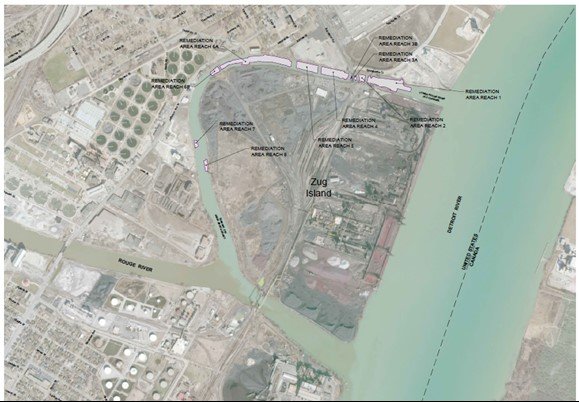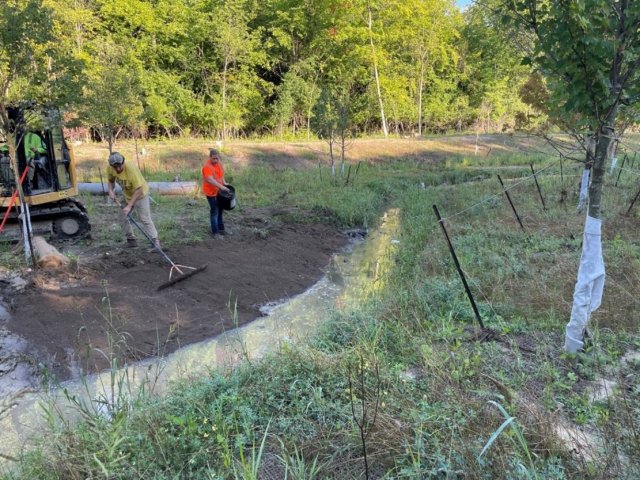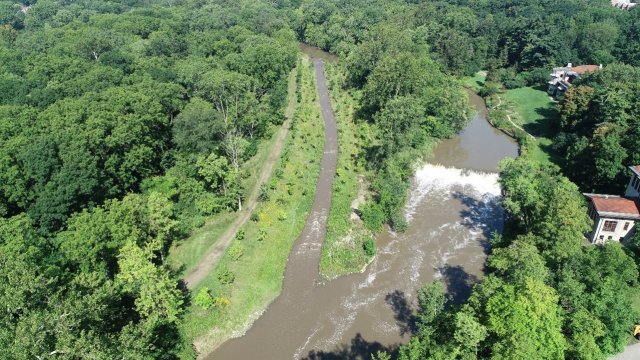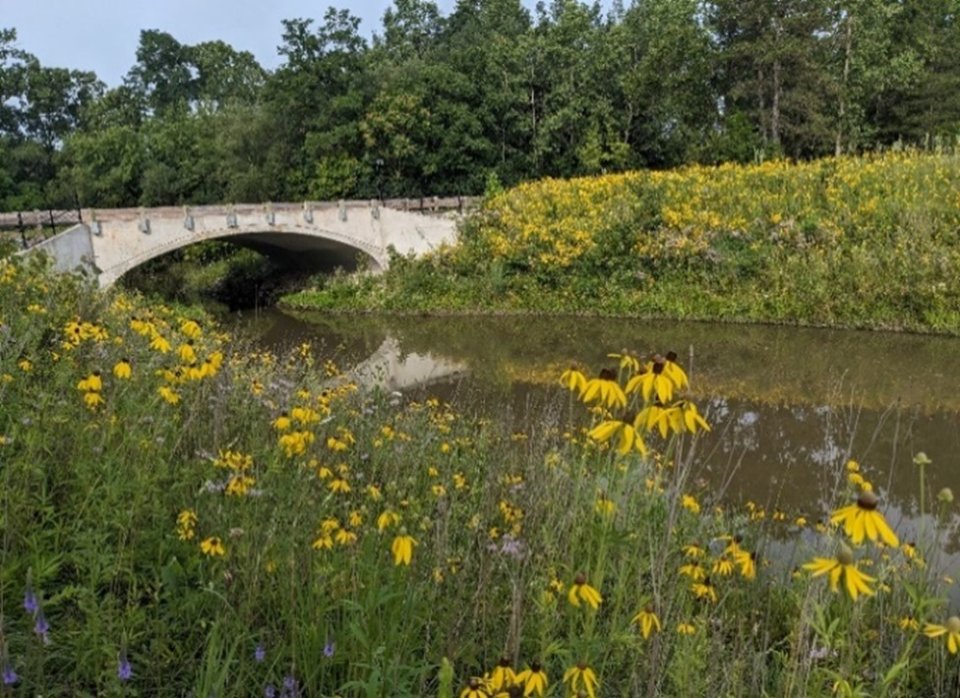Remediation and Restoration Projects for Rouge River AOC
On this page:
- Dredging the Lower Rouge River Old Channel
- Tamarack Creek Stream and Wetland Restoration
- The Henry Ford Estate Dam Fishway Restoration
- The Rouge Oxbow Restoration Project
- Remediation and Restoration Project Table
Remediation and Restoration Project Highlights
Remediation Project Highlight: Dredging the Lower Rouge River Old Channel

Since 2010, EPA has been working under a Great Lakes Legacy Act partnership with its non-federal sponsor, Honeywell Inc. (Honeywell), to investigate, design, and clean up a 0.75-mile stretch of the Lower Rouge River Old Channel (LRROC). The LRROC is a highly industrialized federal navigation channel. The multi-year cleanup effort is to be conducted in multiple portions. The first phase of the project, conducted in 2018 and 2019, included the installation of a sheet pile wall along 2,500 feet of the shoreline completed by Honeywell.

The second phase, dredging, initially contracted in 2018, discovered substantial quantities of previously unanticipated, buried debris resulting in a need for significant revisions to the dredging project scope. To effectively address challenges with the debris, the dredging was split into two phases. Phase 1 of dredging, which resumed in April 2024 and focused on managing debris and removing sediment, was completed in fall 2024. Phase 2 of dredging for the remainder of the project area, tentatively scheduled for 2025 and 2026, will finalize removal and capping of contaminated sediment in the river.
Phase two involves dredging of 70,000 cubic yards of sediment from 10 acres. The sediment is polluted with coal tar and other petroleum products and will be transported offsite by barge and disposed of at the US Army Corps of Engineers Point Mouillee Confined Disposal Facility in Monroe, Mich. In addition, the project will restore the riverbed by stabilizing the shoreline, removing contaminated sediment, and removing large debris like metal, wood, tires, and nearly a dozen vehicles that have been discarded in the river.
Completion of the project will advance efforts toward the removal of the following BUIs:
- Degradation of Fish and Wildlife Populations
- Loss of Fish and Wildlife Habitat
- Degradation of Benthos
Tamarack Creek Stream and Wetland Restoration

The Alliance of Rouge Communities completed a GLRI-funded habitat restoration project on Tamarack Creek, a stream in the Rouge River AOC that primarily drains through an urban landscape. Over time, high levels of uncontrolled stormwater runoff into Tamarack Creek from the urbanized watershed resulted in bank erosion, sedimentation of in-stream habitat, and destabilization of substrate, leading to negative impacts on local macroinvertebrate, fish, and wildlife populations. To address these impairments and ultimately increase fish and wildlife diversity, the Tamarack Creek project included restoration of 1,950 linear feet of stream channel, 4.6 acres of wetland habitat, and construction of in-stream habitat structures. Restoration actions included wetland expansion, stream alignment corrections, and native vegetation planting to slow runoff and improve bank stability. This restoration work was completed in 2022 with $2.3M in GLRI funding and will provide high quality habitat for valuable fish and wildlife, help manage invasive species, and improve hydrology in the watershed.
Restoration Project Highlight: The Henry Ford Estate Dam Fishway
The Henry Ford Estate (HFE) Dam Fish Passage and Habitat Restoration project was identified as a high priority project by the Rouge River Advisory Council in 2011. A naturalized channel was constructed that flows into the Rouge River, bypassing the HFE dam.

The Henry Ford Estate Dam is the first barrier to fish when migrating upstream of the Detroit River. Construction of the fishway channel has opened fish passage between the Rouge River watershed and the Great Lakes system. The completion of this project has reconnected over 40 mainstem river and over 120 tributary miles, which will enhance habitat for many species of fish, macroinvertebrates and other aquatic life. Construction of this fish passage also created two acres of natural riparian habitat along the 850-foot channel. Completion of the project has advanced efforts toward the removal of the following BUIs:
- Degradation of Fish and Wildlife Populations
- Loss of Fish and Wildlife Habitat
- Degradation of Benthos
The Fishway Project was a collaborative effort among many project partners, including:
- U.S. EPA
- NOAA
- National Park Service
- Michigan Department of Natural Resources
- Michigan Department of Environment Great Lakes, and Energy
- Wayne County
- Alliance of Rouge Communities
- Rouge River Advisory Council
Restoration Project Highlight: The Rouge Oxbow

The Rouge Oxbow Restoration Project began in 2002 through collaboration with multiple partners. The Rouge River was channelized in the 1970s to mitigate flooding, which disconnected the Rouge Oxbow area from the Rouge River and prevented fish passage between the oxbow and the Detroit River. To reestablish this connection, part of the Rouge River concrete channel was removed and restored to natural channel so that water could flow freely into and out of the oxbow. The project entered its third phase in 2018 and was completed in 2020.
Over 16 years of efforts to reconnect the system have included channel construction, recreation of 13 acres of wetland and upland habitat, removal of over 7,000 yards of concrete and debris, and construction and reconnection of the southeast portion of the oxbow with the Rouge River. This project reconnected the oxbow with 20 miles of the Rouge River, 100 tributary miles, the Detroit River, and ultimately the Great Lakes watershed. This reconnection provides benefits such as habitat for benthic macroinvertebrates, a resting area for migrating fish, nursery habitat, and restored wetlands. The project created valuable habitat for bass, bowfin, and channel catfish, and also incorporated native seed plantings that will benefit pollinators, stabilize the streambank, and enhance habitat for wildlife.
The Rouge Oxbow Restoration Project will contribute to the removal of the following BUIs:
- Degradation of Fish and Wildlife Populations
- Degradation of Benthos
- Loss of Fish and Wildlife Habitat
The Rouge River Oxbow Restoration Phase 3 Project was a collaborative effort among many project partners, including:
- National Oceanic and Atmospheric Administration
- U.S. Army Corps of Engineers
- Michigan Department of Natural Resources
- Michigan Department Environment, Great Lakes, and Energy
- Wayne County
- Alliance of Rouge Communities
- The Henry Ford Historic Site
- Rouge River Advisory Council
The following table lists remediation and restoration projects in the Rouge River AOC.
| Project Title | Project Description | Date Completed | Targeted BUI(s) |
|---|---|---|---|
| Bell Creek Park Wetlands | This project resulted in the creation of wetlands in a floodplain lawn area of the park, reconnected separated wetlands and created/restored 9.0 acres of habitat. | 2024 |
|
| Colonial & Venoy Restoration | This project improved habitat in Colonial Park and Venoy Dorsey Park by creating 14.5 acres of habitats. | 2023 |
|
| Johnson Intercounty Drain Restoration | The result of this project will improve bank stabilization along the Drain using native trees, shrubs, and grasses, and provide shade for along 3.0 miles of channel and 6 acres upland. | 2026 (est.) |
|
| Lola Valley Park Wetlands |
In the floodplain lawn area of the park this project restored/created 13 acres of habitat in the form of wet meadows and prairie. |
2024 |
|
| Lower Rouge River Habitat Restoration | This project resulted in the removal of 10 existing log jams and problematic instream debris. It also improved 80 acres of forest habitat. |
2024 |
|
| LTU Wetland Restoration | This project resulted in the construction of 1 acre of wetlands and enhanced upland area to improve water flow to wetlands. | 2023 |
|
| Nankin Lake Restoration |
This project restored valuable spawning, nursery, and forage habitat.
|
2023 |
|
| Riverview Park Wetlands | This project resulted in the restoration/creation of a total of 13 acres of native habitat in the form of wet meadows, prairie and riparian habitat. | 2024 |
|
| Rouge Concrete channel restoration | The result of this project will be the evaluation of habitat improvement opportunities along the 2.5 of the 4 miles of the channelized cement portion of the Rouge River. | 2027 (est.) |
|
| Seeley Creek Restoration | This project resulted in the restoration of 5 acres of wetland and 1,600 lft of stream channel, and management of 5 acres for invasive species. | 2023 |
|
| Sherwood Park Wetland | This project resulted in the creation/restoration of a total of 7.0 acres of habitat. | 2024 |
|
| Tamarack/Johnson Fish Hatchery Habitat Restoration Implementation | These projects restored 2,850 ft of creek and 3.2 acres of habitat | 2022 |
|
| Lower Rouge River – Old Channel Great Lakes Legacy Act project | This project involves installation 3,000 lft of seawall and removal of 70,000 CY of contaminated sediments. | 2027 (est.) |
|
| Rouge River - Main Stem Channel Great Lakes Legacy Act project | The result of this project will be further definition of the extent of sediment contamination in the Rouge – Main Stem and determine the amount of sediment that may require remediation as well as feasible and effective remedies for contamination. | 2027 (est.) |
|
| Henry Ford Estate Dam Fish Passage and Habitat Restoration | The project reconnected over 40 mainstem river and over 120 tributary miles. Construction of this fish passage also created two acres of natural riparian habitat along the 850-foot channel. | 2023 |
|
| Rouge Oxbow Phase 3 | This project resulted in the creation of the last hydraulic connection and habitat improvements needed to reconnect the Rouge River oxbow to the main flow of the river. | 2020 |
|
